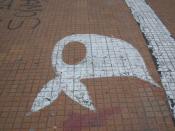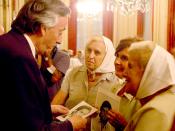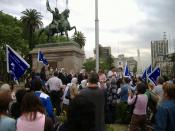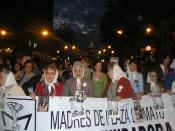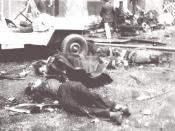The disappearance of thousands of people should not go unnoticed. This is what so many mothers, grandmothers, and family members of Argentina have been fighting about everyday because a radical government took their family members from them. The mothers of the missing citizens, or the Mothers of Plaza De Mayo is an incredible organization fighting for human rights after the people closest to them were taken. The disappearances happened for a reason according to some like Bruce Allen, a writer for the online organization Labournet. But there still is no answer to the question, where are all of the people that went missing from 1974 to 1983? According to Allen, "the deaths can be traced to a United States backed effort to crush the Argentine Left." (Allen p.1) The disappearances started between 1974 and 1975 with about 600 missing person's reports. By 1976 the number of missing grew incredibly and happens to be the same year that the new Military Government was formed and took power.
Around 1976 the mothers of the first missing persons had already formed a group to fight for their right to know where their loved ones were. The efforts of the mothers did not help, meeting at Police Stations and on the streets. Every big institution in Argentina, from the Police to the church had been interviewed but people still wound up missing. The children of the mothers were kidnapped until 1983 and most of them were murdered with some 9,000 unaccounted for in the "dirty war." (p.1 Allen) All of these women were in the same situation. Their children had been taken and killed by a radical government that had no right to take the lives of innocent people.
The women in Argentina were in this situation together and were not alone. All over the globe, especially Latin and South America, the governments and other dictatorship type groups were violating human rights. In Chile, women were chaining themselves to railings of the national legislature and in El Salvador mothers protested through sit-ins in the National Cathedral. Other countries such as Brazil and Sri Lanka formed protest and support groups for the mothers of the country who had their loved ones taken. In Sri Lanka, mothers gathered at national conventions and rallies. (Andrea Malin p.2) About three years after the first disappearances in 1977 the mothers of Argentina formed the group The Mothers of Plaza de Mayo. The mothers had a goal to keep the memory of their lost loved ones alive, so people would never forget the tragedy that has occurred in their lives. "The mothers first ventured into the Plaza de Mayo in April of 1977. In the beginning they were a group of fourteen but by 1982 the group had spread out to over 2,500." (Andrea Malin p.2) The mothers would wear white kerchiefs and marched around the Plaza de Mayo with pictures of their missing loved ones. The mothers have met every Thursday at 3:30p.m. since 1977 and still practice this today. (Andrea Malin p.2) According to the mothers, marching gave them strength and helped the mothers to not feel quite so alone.
Since 1977, The Mothers of the Plaza de Mayo have gone through a period of large of growth. They go to police stations, churches, and even door-to-door looking for new recruits to help represent the importance of the cause. Most people did not welcome these mother's ideas. One mother reflects on her experiences by saying, "At the beginning we told them what we thought they had to do and whom they had to see."(madres.org p.5) This is how the Mothers of Plaza de Mayo expanded. The women were not welcomed in the Plaza by the authorities at first, and were even physically assaulted. Some say that their growth and dedication is pointless and they are just walking in circles. The mothers say that they want their walks to be recognized as a protest march. "The march is going towards something. Even though in a circle we Mothers believe that we are marching towards a destination." (madres.org p.2) Even today the mothers are a recognizable force in human rights advocacy. The mothers' efforts have earned them rewards from groups such as UNESCO and the European Parliament. They have also received a lot of support all over the globe. For example, in Paris, France supporters march at the Argentine embassy of France every Thursday. There has been plenty of negative attention. The media all over the world has been against them saying that they are anti-nationalists. The group has also received negative attention from governments and authorities. They have received multiple threats from different organizations and anti-government forces. The group's offices, in Buenos Aires are sometimes robbed. Some of the founding members were even kidnapped in the beginning years of the group's efforts. This negative feedback does not seem to affect the Mothers of the Plaza, and they continue to remain surprisingly strong. "Our desire to find our sons is stronger than our fright because when we are thinking about our children, we do not think about our suffering."(madres.org p.15) The mothers are now trying to establish schools in their offices with the goal to educate people to take action in their lives politically.
Fighting for human rights is so very important, even though the enemy seems indestructible. The Mothers of Plaza de Mayo are not fighting just for the missing loved ones of Argentina, but for society as a whole and for the human rights and justice for all. If one person's life is saved because of the efforts, all of the years of fighting are worth the struggle. The Mothers of Plaza de Mayo believe in one of the strongest things we have as one world. They believe in the youth of the world. The mothers know that we have to put all of our hopes in the youth if we want this world to ever be in peace. "Defeat does not exist, as long as mothers walk around the Plaza with a scarf on their heads, as long as there are young men and women, priests and children working against injustice." (madres.org p.15)
